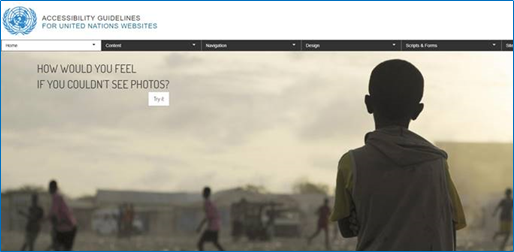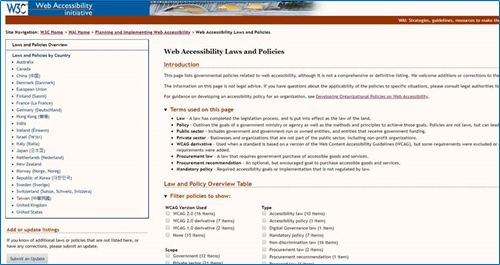The ability to access the internet is increasingly seen as a fundamental human right. Tim Berners-Less, one of the inventors of the WorldWideWeb and a director the World Wide Web Consortium (W3C) notes that “The power of the Web is its universality. Access by everyone regardless of disability is an essential aspect”. Accessibility for the disabled, is a growing concern. While the United Nations set out guidelines as far back as 2006, countries have been slow to adopt them. But the tide now looks to be turning.
The European Union (EU) implemented the accessibility best practices in 2010. In 2017, over 400 U.S. companies were served with lawsuits under the Americans with Disabilities Act (ADA) because their websites were not deemed accessible to the disabled. Websites are increasingly recognized as public places, and therefore need to be more mindful of public accessibility. Today, more than 4 billion people use the web for: “education, employment, government, commerce, health care, recreation, access to information and more” (Source: United Nations). To be denied access to the web is an impediment to normal life and life’s opportunities in our 21st century world. Companies need to take note.
Let’s start with some background on Web Accessibility. The World Wide Web Consortium (W3C) has always been a major advocate for website accessibility. The W3C is an international community whose members (some +/-500 of the world’s largest organizations), staff, as well as public contributions all work together to develop standards to help manage and organize the web. It’s good to know that W3C is still led by Tim Berners-Lee. The W3C's mission is to “lead the web to its full potential”. The W3C has its own Web Accessibility Initiative (WAI) to deliver web accessibility to all web users. This has evolved into the Web Content Accessibility Guidelines (WCAG) 2.1 which sets out guidelines and techniques. There are 12 guidelines organized under 4 principles: perceivable, operable, understandable and robust. Each guideline has testable success criteria, which are graded into three levels: A, AA, and AAA. Click this link if you want to go straight to source: www.w3.org/WAI
Our IBT Online recommendations for your Web Accessibility challenges:
- Audit your website, get an evaluation on how to fix any lacunae. This can be done manually by WCAG 2.0 AA accredited web professionals (IT, web designers…).
- There are various online tools: check out W3C guidance, Selecting Web Accessibility Evaluation Tools: https://www.w3.org/WAI/eval/selectingtools#cannot
- A useful online tool is to plug your URL into this WAVE Web Accessibility Tool: https://wave.webaim.org/
- Video’s, WCAG 2.0 explainers and service providers
- Don’t forget to review your mobile applications…
- Contact IBT Online and lets work together to get you Web Accessibility compliant
When it comes to the internet, the W3C certainly has clout, soft-power and influence. Nevertheless, worldwide adoption and implementation of W3C Web Accessibility guidelines requires that the heavy lifting be done by international organizations and national governments. Looks like a job for the United Nations (UN). We should all be grateful to the UN for championing the cause of universal accessibility with its own General Assembly mandate back in 2006, advising member states to comply with W3C guidelines. The UN notes that “Accessible websites benefit everyone, not just those with disabilities. On an accessible website, the user is put at the centre of the experience. Text is more readable. Content is better organized. The design is clean and simple”. The UN has been a great driving force for global web accessibility, although global adoption and progress has been patchy to say the least.

The European Union (EU), waited until 2010 to implement the accessibility best practices. The EU Commission (responsible for proposing legislation, implementing decisions, upholding the EU treaties and managing the day-to-day business of the EU) adopted W3C guidelines and issued a number of directives to monitor and support web accessibility implementation efforts and publish progress across Europe.
The Commission issued its European Union Internet Handbook and the Information Providers Guide (IPG) which is for everyone “who develops and publishes material on EU websites, including webmasters, editors, content providers, web developers and contractors. The guide covers all aspects of publishing on the EUROPA site, describing the relevant editorial, technical and presentation standards in force. The rules set out in the IPG are compulsory in order to ensure a coherent and user-friendly service to the users. The IPG is freely available on EUROPA in English, and is a living document which is regularly updated. These guidelines explain how to make web content accessible to people with disabilities. The guidelines are intended for all web content developers. The primary goal of these guidelines is to promote accessibility. If you are online in the EU you need to be aware of and apply these guidelines. Since 2010, websites in Europe have had to be W3C compliant and today that means WCAG 2.1 compliant. For those of you who want to go back to the source, here you go: www.ec.europe.eu
Things are less clear-cut in the United States. Over the past several years, the Department of Justice (DOJ) has talked about issuing regulations specifically about Web Accessibility, although on December 26, 2017, the DOJ announced that discussions on these regulations were officially withdrawn. However, the US Courts and the rising tide of plaintiffs alleging violations of the Americans with Disabilities Act (ADA) Website Accessibility are taking matters forward into their own hands. A New York Times article on October 11, 2017 with the title “College Websites Must Accommodate Disabled Students, Lawsuit Says” pointed to the more than 400 website ADA accessibility class action lawsuits filed in the first 8 months of 2017. This is a huge jump from the +/- 250 lawsuits filed in 2015 and 2016 combined! Also noteworthy is the widening industry net (get it?) as lawsuits were first limited to targeting the retail and hospitality industries, but now include the insurance, financial and educational (colleges…) sectors.
At its core, the lawsuits hinge on Title III of the ADA, 42 U.S.C. § 12182(a), which prohibits discrimination against disabled individuals, including the blind and visually impaired, in places of public accommodation. The US District Court for the Southern District of Florida verdict in June 2017, was the first-of-its-kind ADA website accessibility trial. The court ruled Winn-Dixie’s (Your Neighborhood Grocery Store) website constituted a place of public accommodation under the ADA. There are other notable cases in the U.S. that are driving compliance concerns: in August 2017 New York, Andrews v. Blick Art Materials, LLC, followed by Five Guys Burgers and Hobby Lobby… all concluded that websites constitute a place of public accommodation under the ADA. US companies are now seeking to understand Web Accessibility challenges. To avoid litigation they are turning to back to the W3C and WCAG 2.1.
The W3C monitors Web Accessibility UN, international organization and governmental efforts and achievements worldwide, you can see Web Accessibility Laws and Policies by Country at: https://www.w3.org/WAI/Policy/



